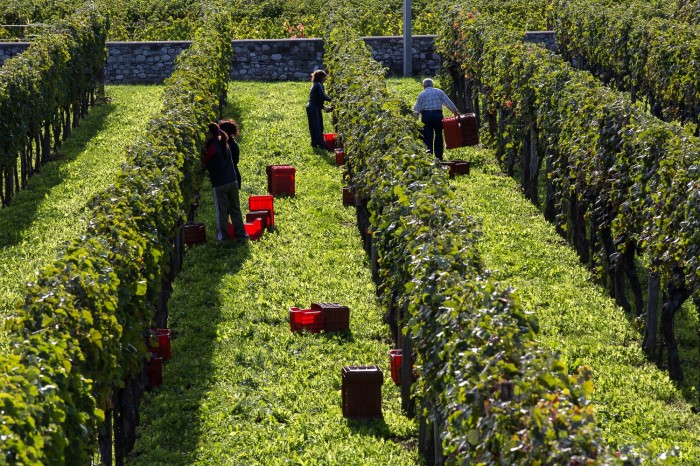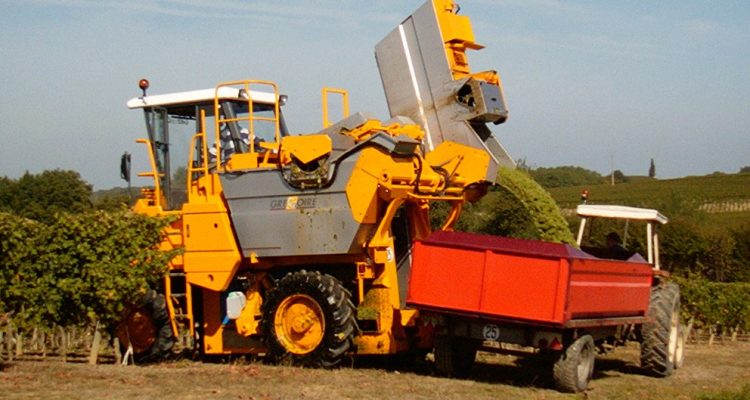Stanford linguistic professor Dr. Dan Jurafsky’s recent book on The Language of Food: A Linguist Reads the Menu includes a perspicacious observation about high-class versus budget restaurant menus. Explicit adjectives about yumminess are pretty much the sole purview of the bottom lot. Red Lobster will offer you flaky cod fillets hand-dipped in real beer batter and fresh garden salad with vine-ripened tomatoes; RN74 or Ottolenghi likely lists just cod, tomatoes. We’ll safely assume that the beer in the batter is real, the salad fresh, and if the fillets aren’t hand-dipped it’s because they’ve devised some ingenious machine that does the job better. Extra adjectives are filler words – you say “delicious, crispy chicken” when you can’t name heritage breed and provenance – but they’re also a reassurance that disconcertingly points toward the potential for doubt. The phrase “made with real butter,” after all, only emerged after margarine became popular.
So what to think when a label’s back half boasts hand-picked or hand-harvested grapes? Should we be suspicious of machine-harvesting, and is machine-harvesting bad? Surely that’s the implication, or why would anyone brag about it? The vast majority of wine is made from machine-harvested grapes. Great: it keeps the price down on the $8 chardonnays that no one expects to be hand-crafted. But even if some of us do more or less regularly drink mass-produced industrial wines, we all know that hand-craftsmanship is best.
Except when it’s not. Sometimes sacrificing uniqueness to consistent uniformity is no sacrifice at all; if wine bottles were still hand-blown, they’d leak a lot more and screwcaps wouldn’t be an option. They might have attractive personal touches, but we’d also be paying a lot more for the privilege. (Though I’d best stop thinking along this line before I argue that a hand-blown glass standard would mean status-quo bottle refilling and less frivolous waste and a better world for us all, which is an interesting point about mechanization for a different day.)
 Machine harvesting’s inferred inferiority is far from a given, more often marketing than meaningful difference. Winemaking is always about control. Machine harvesting affords more of some kinds of control than hand-picking and so can be an acceptable substitute for and even preferable over traditional handwork. Machines are, moreover, less expensive than manpower and being pretentious about that point is pointless; even strictly quality-focused producers can turn savings in one area into an expenditure with a bigger quality payout elsewhere or, heck, a lower bottle price.
Machine harvesting’s inferred inferiority is far from a given, more often marketing than meaningful difference. Winemaking is always about control. Machine harvesting affords more of some kinds of control than hand-picking and so can be an acceptable substitute for and even preferable over traditional handwork. Machines are, moreover, less expensive than manpower and being pretentious about that point is pointless; even strictly quality-focused producers can turn savings in one area into an expenditure with a bigger quality payout elsewhere or, heck, a lower bottle price.
Machine harvesting means beating up the vines. Beater bars either jostle through the vine canopy or thwack the trunks, in either case shaking ripe clusters off branches onto collecting trays. En route to collecting gondolas, various increasingly fancy fans and sorters eliminate leaves, stems, and other Material Other than Grapes (MOG) so that, in the ideal scenario, the truck ends up resembling a bowl of blueberries: whole, single grapes. More commonly all of that thwacking splits open some fruit, but suffice it to say that these machines have become much better since their advent in the 1960’s when you could fairly say that they doubled as juicers. (Incidentally, an earlier model that substituted a cutter bar for the thwacking debuted in 1954, but didn’t last because it required hand-positioning individual clusters before harvest so that they could be cut in the correct spot). The operation is less thuggish than it sounds: because the beater bars – “bow bars,” actually – don’t remove the fruit by brute force but by some precisely calculated physics of quick movements in opposing directions to release more or less only ripe fruit, the vines don’t take as much of a thrashing as you might think.

The control mechanical harvesters lack is in deciding what to pick. They can’t, much. Adjusting the parameters on those beater bars – height, speed, oscillations – helps, but the machine can’t choose only perfect ripe clusters and leave a second crop or moldy grapes behind the way a trained team can. Whole cluster fermentation is also out. On the other hand, the harvester itself weeds out a lot of the non-grape matter that would otherwise warrant a pass through a sorting table, destemmer, or both. Eliminating those steps saves not only money and fuss but time, moving grapes to fermentation faster.
Speed ends up being one of mechanical harvesting’s best qualities. The machine option gives a winemaker more control over when to pick: deciding to harvest means calling one driver instead of mobilizing an entire crew, and machines generally move faster. Combine that with the ability to harvest at night – without bright lights, or keeping everyone up and paying them extra – and winemakers can bring fruit in precisely when they want and get it to the fermentation tanks in quick order. That precision demonstrably pays off with Marlborough sauvignon blanc. Research in 2011 concluded that machine-harvested “savvy” grapes actually make better wine, so long as your definition of better means more of that intense tropical fruit flavor that, if you’re dealing Marlborough Sauvignon Blanc, is probably precisely what you’re going for. Machine harvesting in this case meant less juice oxidation and consequently higher concentrations of the specific thiol molecules, destroyed by oxygen, responsible for that characteristic passionfruit flavor in the finished wines.
Older studies showed, even back in 1980 with harvesters much less sophisticated than present-day models, that machine-harvesting itself wasn’t better or worse than hand-picking. Harvest-related quality differences were all about temperature and how long the fruit had to sit before processing; when machines harvest cold fruit at night and move it quickly to a nearby winery they were the better option, not so in other cases. In 1980, then again, mechanical harvesters crushed fruit, didn’t sort out MOG as tidily, and delivered a soup that could easily deliver unwanted flavors if left to sit for very long. Some of our anti-mechanization prejudices are a hold-over from those days.
And some exceptions still stand. Delicate old vines can’t stand beater bars. Finer pinot noirs, perhaps, can’t stand even minor fruit crushing in the vineyard without extracting unwanted phenolics. Nonetheless, proud proclamations about hand-harvesting are mostly preying on our cultural assumptions about the natural superiority of people over machines. Labor shortages or no, wine is bound (hide-bound, maybe) to be a hold-out of that sentiment even as we become more globally accepting of robots in their various people-replacing roles. Until and unless our feelings about wine as a craft or even artisan product change, redefining the guy in charge as the wine artistic director instead of the winemaker per se, we’ll keep up at least the conceit of bowing to the hands-on winemaking pedestal.
But that change is already happening, sort of, and here we return to the linguistics of menus. At McDonalds, you know that your burger was machine-extruded and you don’t care. You’re at McDonalds for reasons that have nothing to do with hand-craftsmanship. At the neighborhood steak house – the one with the candles on the table where you took your current beau or belle on Friday night – you do care that your hamburger was hand-formed. But if you dine at Per Se and are offered a hamburger, you wouldn’t be surprised (or at least, let’s say, no more surprised than you are by anything that happens on your plate at Per Se) to learn that it had been machine-extruded to achieve a precisely controlled result that, in this singular case, created a better product. The comparison is imperfect – hand-formed burgers really are better in nearly every case – but the point stands. When machines are employed in the service of deliberate precision, they need not be a second-best. “Hand-harvested” is about our expectations and the message we’re trying to send; we’re choosing “my wine is an artisan product” over “my wine is a packaged food like any other packaged food” or “my wine is a way to get sloshed.” If that suits your purposes, splendid. But if anyone asks, the difference is usually more about the chemistry in your brain than in your glass.

